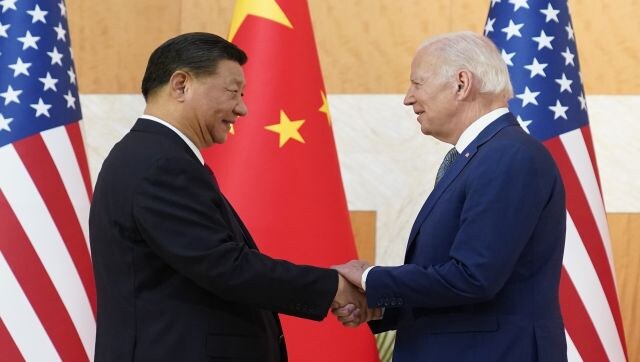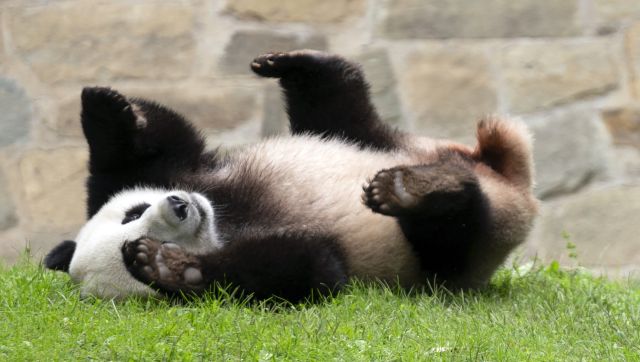US president Joe Biden and his Chinese counterpart Xi Jinping met for four hours at Filoli Estate in California, on the sidelines of the APEC summit. The two countries resolved to restore military communications and reached an agreement to reduce fentanyl manufacturing. Chinese president Xi Jinping also signalled late Wednesday that China will send new pandas to the United States. But why were pandas being spoken of during
diplomatic talks
between the two countries. Let’s take a closer look. Symbol of friendship China’s gigantic pandas have been a potent diplomatic tool, used to fortify relationships, lure new partners, and cultivate goodwill, for more than 50 years. On Wednesday, president Xi Jinping called them “envoys of friendship between the Chinese and American peoples,” and promised to send new panadas to the US. “We are ready to continue our cooperation with the United States on panda conservation, and do our best to meet the wishes of the Californians so as to deepen the friendly ties between our two peoples,” Xi said during a dinner speech with business leaders. [caption id=“attachment_13393462” align=“alignnone” width=“640”] Chinese president Xi Jinping also signalled late Wednesday that China will send new pandas to the United States. AP[/caption] The gesture came at the end of a day in which Xi and President
Joe Biden
held their first face to face meeting in a year and pledged to try to reduce tensions. Xi did not share additional details on when or where pandas might be provided but appeared to suggest the next pair of pandas are most likely to come to California, probably San Diego. The bears have long been the symbol of the US-China friendship since Beijing gifted a pair of pandas to the National Zoo in Washington in 1972, ahead of the normalisation of bilateral relations. Later, Beijing loaned the pandas to other US zoos, with proceeds going back to panda conservation programs. Panda politics The National Zoo’s three giant pandas, Mei Xiang, Tian Tian and their cub Xiao Qi Ji, eight days ago began their long trip to China. After their departure, only four pandas are left in the United States, in the Atlanta Zoo. “I was told that many American people, especially children, were really reluctant to say goodbye to the pandas, and went to the zoo to see them off,” Xi said in his speech. He added that he learned the San Diego Zoo and people in California “very much look forward to welcoming pandas back.” Xi is in California to attend a summit of Indo-Pacific leaders and for his meeting with Biden. He made no mention of the pandas during his public remarks earlier in the day as he met with Biden.
Also Read: Joe Biden calls Xi Jinping a ‘dictator’ after 4-hour talks. What did they discuss?
When bilateral relations began to sour in the past few years, members of the Chinese public started to demand the return of giant pandas. Unproven allegations that US zoos mistreated the pandas, known as China’s “national treasure,” flooded China’s social media. But relations showed signs of stabilisation as Xi travelled to San Francisco to meet with Biden. The two men met for about four hours Wednesday at the picturesque Filoli Historic House & Garden, where they agreed to cooperate on anti-narcotics, resume high-level military communications and expand people-to-people exchanges. The National Zoo’s exchange agreement with the China Wildlife Conservation Association had been set to expire in early December and negotiations to renew or extend the deal did not produce results. The San Diego Zoo returned its pandas in 2019, and the last bear at the Memphis, Tennessee, zoo went home earlier this year. The start of panda diplomacy Beijing’s panda diplomacy with Washington began in 1972, following President Richard Nixon’s historic visit to China. President Richard M Nixon had just arrived in Beijing, becoming the United States’ first president to visit the People’s Republic of China, The Washington Post reports. The future of the Cold War and America’s uncertain relations with China — a Communist nation and longtime foe — were at stake. [caption id=“attachment_13393392” align=“alignnone” width=“640”]
Chinese president Xi Jinping also signalled late Wednesday that China will send new pandas to the United States. AP[/caption] The gesture came at the end of a day in which Xi and President
Joe Biden
held their first face to face meeting in a year and pledged to try to reduce tensions. Xi did not share additional details on when or where pandas might be provided but appeared to suggest the next pair of pandas are most likely to come to California, probably San Diego. The bears have long been the symbol of the US-China friendship since Beijing gifted a pair of pandas to the National Zoo in Washington in 1972, ahead of the normalisation of bilateral relations. Later, Beijing loaned the pandas to other US zoos, with proceeds going back to panda conservation programs. Panda politics The National Zoo’s three giant pandas, Mei Xiang, Tian Tian and their cub Xiao Qi Ji, eight days ago began their long trip to China. After their departure, only four pandas are left in the United States, in the Atlanta Zoo. “I was told that many American people, especially children, were really reluctant to say goodbye to the pandas, and went to the zoo to see them off,” Xi said in his speech. He added that he learned the San Diego Zoo and people in California “very much look forward to welcoming pandas back.” Xi is in California to attend a summit of Indo-Pacific leaders and for his meeting with Biden. He made no mention of the pandas during his public remarks earlier in the day as he met with Biden.
Also Read: Joe Biden calls Xi Jinping a ‘dictator’ after 4-hour talks. What did they discuss?
When bilateral relations began to sour in the past few years, members of the Chinese public started to demand the return of giant pandas. Unproven allegations that US zoos mistreated the pandas, known as China’s “national treasure,” flooded China’s social media. But relations showed signs of stabilisation as Xi travelled to San Francisco to meet with Biden. The two men met for about four hours Wednesday at the picturesque Filoli Historic House & Garden, where they agreed to cooperate on anti-narcotics, resume high-level military communications and expand people-to-people exchanges. The National Zoo’s exchange agreement with the China Wildlife Conservation Association had been set to expire in early December and negotiations to renew or extend the deal did not produce results. The San Diego Zoo returned its pandas in 2019, and the last bear at the Memphis, Tennessee, zoo went home earlier this year. The start of panda diplomacy Beijing’s panda diplomacy with Washington began in 1972, following President Richard Nixon’s historic visit to China. President Richard M Nixon had just arrived in Beijing, becoming the United States’ first president to visit the People’s Republic of China, The Washington Post reports. The future of the Cold War and America’s uncertain relations with China — a Communist nation and longtime foe — were at stake. [caption id=“attachment_13393392” align=“alignnone” width=“640”] The bears have long been the symbol of the US-China friendship since Beijing gifted a pair of pandas to the National Zoo in Washington in 1972, ahead of the normalisation of bilateral relations. File image/Reuters[/caption] First Lady Pat Nixon was seated close to Premier Zhou Enlai, China’s high-ranking leader, second only to Chairman Mao Zedong himself, at their welcoming feast. The first lady noticed a small tin of smokes on the table with the emblem of two pandas on it. “Aren’t they cute?” She stated. “I love them.” “I’ll give you some,” Zhou said to the first lady. “Cigarettes?” she clarified. “No,” Zhou replied. “Pandas.” First lady Pat Nixon welcomed the pandas, stating, “They will be enjoyed by the millions of people who come from across the country to visit the nation’s capital each year.” As the pandas’ popularity among Americans grew, China sent more of the adorable and fascinating beasts to other zoos across the country, eventually loaning them rather than gifting them. As per a CNN report, at the peak of the programme, there were 15 pandas in the United States at one time, but the numbers have declined over the last decade, corresponding with worsening US-China relations. The countries with Chinese pandas According to a 2013 Oxford University study, China’s panda accords with Canada, France, and Australia coincided with uranium sales and contracts with those countries. Similarly, panda exchanges with neighbours such as Singapore, Malaysia, and Thailand were associated with the signing of free-trade agreements and accords, reports The Washington Post. According to a 2021 study, the number of pandas granted strongly correlated with a country’s trade volume with China. Countries that have received pandas in recent years include Finland, the Netherlands, and Denmark. Last year, Qatar welcomed its first panda. During a 2019 visit to Russia, Chinese president Xi Jinping handed over two pandas on a 15-year loan to Russian president Vladimir Putin. There are currently 23 countries with pandas on loan from China, including the United States, although that number is decreasing. Scotland will lose its two pandas in December when the Edinburgh Zoo is forced to return them to China; Australia’s Adelaide Zoo will only have two pandas for another year. With inputs from AP
The bears have long been the symbol of the US-China friendship since Beijing gifted a pair of pandas to the National Zoo in Washington in 1972, ahead of the normalisation of bilateral relations. File image/Reuters[/caption] First Lady Pat Nixon was seated close to Premier Zhou Enlai, China’s high-ranking leader, second only to Chairman Mao Zedong himself, at their welcoming feast. The first lady noticed a small tin of smokes on the table with the emblem of two pandas on it. “Aren’t they cute?” She stated. “I love them.” “I’ll give you some,” Zhou said to the first lady. “Cigarettes?” she clarified. “No,” Zhou replied. “Pandas.” First lady Pat Nixon welcomed the pandas, stating, “They will be enjoyed by the millions of people who come from across the country to visit the nation’s capital each year.” As the pandas’ popularity among Americans grew, China sent more of the adorable and fascinating beasts to other zoos across the country, eventually loaning them rather than gifting them. As per a CNN report, at the peak of the programme, there were 15 pandas in the United States at one time, but the numbers have declined over the last decade, corresponding with worsening US-China relations. The countries with Chinese pandas According to a 2013 Oxford University study, China’s panda accords with Canada, France, and Australia coincided with uranium sales and contracts with those countries. Similarly, panda exchanges with neighbours such as Singapore, Malaysia, and Thailand were associated with the signing of free-trade agreements and accords, reports The Washington Post. According to a 2021 study, the number of pandas granted strongly correlated with a country’s trade volume with China. Countries that have received pandas in recent years include Finland, the Netherlands, and Denmark. Last year, Qatar welcomed its first panda. During a 2019 visit to Russia, Chinese president Xi Jinping handed over two pandas on a 15-year loan to Russian president Vladimir Putin. There are currently 23 countries with pandas on loan from China, including the United States, although that number is decreasing. Scotland will lose its two pandas in December when the Edinburgh Zoo is forced to return them to China; Australia’s Adelaide Zoo will only have two pandas for another year. With inputs from AP
Will pandas return to the US following Xi Jinping and Joe Biden's talks?
FP Explainers
• November 16, 2023, 16:25:30 IST
Xi Jinping has signalled that Beijing will send new pandas to the United States, calling them ‘envoys of friendship between the Chinese and American peoples’
Advertisement
)
End of Article